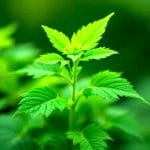Takeaways
- Stinging nettle contains compounds that may reduce inflammation
- Traditional medicine has used nettle for centuries to treat pain
- Research suggests nettle could help with arthritis and muscle soreness
- Nettle can be used topically or taken as a supplement for pain relief
- Always consult a doctor before using nettle for medical purposes
Nature’s Prickly Healer
Stinging nettle is a common plant with a surprising dual nature. It’s well-known for causing a stinging sensation upon touch.[1] However, it also has potential benefits for easing pain.[2] Historically, people have used nettle to relieve discomfort, and modern research is now exploring these traditional uses further.
Nettle plants grow naturally in many places, such as fields and along paths.[3] Their leaves and stems are covered with tiny, needle-like hairs.[4] These hairs release chemicals that cause the characteristic sting. When processed correctly, nettle can be used for its potential healing properties.[5]
There’s a growing interest in natural pain management solutions. Many people are looking for alternatives to conventional medications. Nettle is a plant-based option that’s readily available and, when used appropriately, has few reported negative effects.[6]
What Is Stinging Nettle?
Plant Profile
Stinging nettle, scientifically known as Urtica dioica, is a perennial flowering plant.[7] It typically reaches a height of 3 to 7 feet and has pointed, saw-toothed leaves.[8] The plant is covered in stinging hairs called trichomes, which help in identifying it.[9]
Nettle plants flourish in soil that is rich in nitrogen.[10] They are often found close to human activity.[11] They grow well in disturbed areas, including fields and roadsides. Nettle can tolerate both partial shade and full sunlight.[12]
Key identification features of stinging nettle include its serrated leaves, the presence of stinging hairs, and a typical height of 3-7 feet. These characteristics help distinguish it from other plants.
- Green, heart-shaped leaves with jagged edges
- Leaves grow in opposite pairs along the stem
- Tiny greenish flowers hang in clusters
- Stinging hairs visible on stems and leaves
The Sting
The stinging sensation from nettle is caused by its hollow hairs, which act like tiny needles.[13] When touched, these hairs break off, injecting irritating chemicals into the skin.[14] This causes a burning, itching, and sometimes swelling upon contact.[15]
While the sting from nettle is usually painful, it’s generally not harmful and often subsides within about an hour.[16] Some individuals even intentionally expose themselves to nettle stings for potential pain relief, a practice known as urtication.[17]
| Plant | Sting Sensation | Duration |
|---|---|---|
| Stinging Nettle | Sharp, burning | 30-60 minutes |
| Poison Ivy | Itchy rash | Days to weeks |
| Fire Ant | Sharp, burning | Several days |
Historical Use for Pain Management
Traditional Medicine
Nettle has been used in herbal medicine for a long time. Ancient Greeks and Romans used it to help with arthritis.[18] Native Americans used nettle leaves to soothe sore muscles.[19] In medieval Europe, nettle tea was a common remedy for various aches.[20]
Traditional uses of nettle for pain include remedies for joint pain, muscle soreness, and general discomfort.[21] Nettle has been applied topically and consumed as a tea for pain relief.
- Drinking nettle tea for gout
- Applying nettle leaves to sprains
- Whipping sore joints with fresh nettle (urtication)
- Eating cooked nettle to ease menstrual cramps
Folk Remedies
Nettle is valued by folk healers for its varied uses. Many cultures have traditional nettle remedies passed down through generations. For example, in Russia, nettle-infused vodka is used for rheumatism.[22] In Britain, herbalists often suggest nettle soup for back pain.[23]
How nettle is perceived differs by region. Some consider it a versatile cure-all, while others see it primarily as a nutritious food source. However, the use of nettle for pain relief is common across many different cultures.
How Stinging Nettle Tackles Pain
Active Compounds
Nettle contains a variety of biologically active substances. These compounds interact with the body in complex ways. Scientists are still investigating exactly how these substances work together.
| Compound | Potential Effect on Pain |
|---|---|
| Flavonoids | Anti-inflammatory |
| Lignans | Antioxidant |
| Lectins | Immune system modulation |
| Carotenoids | Reduce oxidative stress |
The various compounds in nettle might work synergistically, meaning their combined effect is greater than the sum of their individual effects.[24] This synergy likely contributes to nettle’s potential pain-relieving properties.
Mechanisms of Action
Nettle appears to alleviate pain through multiple mechanisms. Its anti-inflammatory properties are well-established.[25] Reducing inflammation is important, as it plays a significant role in many pain conditions.
Nettle may also influence how the body perceives pain. Some research indicates it could affect neurotransmitters involved in pain signaling.[26] Additionally, the antioxidants in nettle may help reduce tissue damage that can lead to pain.[27]
Stinging nettle’s potential pain relief may stem from its ability to reduce inflammation, impact pain signals, and provide antioxidant benefits. Each of these mechanisms may contribute to its overall effect.
- Reducing inflammation
- Modulating pain signals
- Protecting against oxidative stress
- Supporting joint and muscle health
Types of Pain Stinging Nettle May Help
Nettle shows some promise in helping with various pain-related conditions. However, ongoing research is necessary to confirm these effects. Some of its uses have stronger scientific support than others.
The strongest scientific evidence for nettle’s pain relief is for arthritis.[28] Several studies suggest that nettle can help reduce pain and increase mobility for those with osteoarthritis.[29] People with rheumatoid arthritis may also experience some benefit.[30]
Nettle is also being studied for potential use in relieving pain from muscle soreness, lower back pain, and nerve pain.[31] These are areas where initial research and traditional use suggest possible benefits.
- Muscle soreness
- Lower back pain
- Menstrual cramps
- Headaches
- Tendonitis
Further investigation is needed in many of these areas. However, the traditional use of nettle, along with initial study results, offer promising indications for its potential use in pain management.
Forms and Preparations
Nettle can be prepared and used in different forms for pain relief. Each method has its own particular applications and advantages. The most appropriate form for use depends on the type of pain being addressed and individual needs.
Fresh nettle leaves can be applied directly to painful areas. This method, known as urtication, uses the stinging effect of nettle.[32] It is thought to overwhelm pain signals. Dried nettle leaves, while no longer stinging, retain other beneficial compounds.
Common forms of stinging nettle used for pain management include fresh leaves for topical use, dried leaves for teas, and extracts or capsules for oral consumption.[33] Each method offers different ways to access nettle’s potential benefits.
- Dried leaf tea
- Capsules or tablets
- Tinctures
- Topical creams
- Fresh leaf poultices
Dosage and Administration
Using the correct dosage is essential to ensure that nettle works effectively. Using too little may not provide any benefit. Too much could cause unwanted effects. It’s best to start with a small amount and gradually increase as needed.
When making nettle tea, use 1-2 teaspoons of dried leaves in hot water and steep for several minutes. One to three cups per day is a typical amount.[34] For capsules, dosages typically range from 300 to 500 mg, taken one or two times, two to three times daily.[35]
Topical nettle use varies significantly. It is important to follow specific product instructions or consult with a qualified herbalist. Individuals react differently to herbal treatments; it is wise to adjust your use according to your body’s feedback.
Potential Side Effects and Precautions
Nettle is considered generally safe when used properly. However, like all treatments, there’s a chance of some side effects. These are often mild and temporary. Serious side effects are rare, but still a possibility.
Common side effects of nettle include stomach upset and skin irritation.[36] Allergic reactions can occur, especially if someone is already allergic to related plants.[37] Nettle can also interact with some prescription medications.[38]
Individuals who may want to avoid using stinging nettle include pregnant or breastfeeding people, those with certain allergies, and people taking specific medications. Consulting a doctor is always recommended beforehand.
- Pregnant women (may stimulate contractions)
- People with kidney problems
- Those taking blood thinners
- Individuals with low blood pressure
It is always important to consult with a healthcare professional before using nettle for pain relief. This is especially crucial if you have any existing health issues or take prescription medications.
Interactions with Medications
Nettle can interact with several types of medications. These interactions might increase or decrease the effectiveness of the drugs. In some situations, these interactions could have potentially harmful effects.
Blood thinners, such as warfarin, are a significant concern. Nettle could increase their effect, thereby raising the risk of bleeding.[39] Nettle may also interfere with drugs for high blood pressure and diabetes.[40]
| Medication Type | Potential Interaction |
|---|---|
| Blood thinners | Increased bleeding risk |
| Diuretics | Enhanced effects |
| NSAIDs | Possible increased effectiveness |
| Diabetes drugs | May lower blood sugar further |
Always let your doctor know if you are using nettle. They can advise you about any potential interactions with your current medications and adjust your treatment plan as necessary.
Scientific Evidence
Current Research
There is increasing scientific interest in the potential of nettle. Several studies have been carried out on its pain-relieving properties. While the findings are promising, more research is still necessary.
A 2013 study found evidence that nettle may be helpful in treating osteoarthritis. Participants reported a reduction in pain and used fewer painkillers.[41] Another study indicated that nettle extract could ease muscle soreness after exercise.[42]
Ongoing research is focused on how nettle works within the body. One study found it could inhibit certain inflammatory enzymes. This finding supports its traditional application for inflammatory conditions.[43] More extensive human studies are still needed, as many are smaller or use animals.
Future Directions
Future studies will likely investigate several key areas. Scientists want to identify the specific active compounds in nettle. This could lead to more precise treatments. Research into optimal dosage and long-term safety is also required.
Researchers are exploring nettle for use in specific pain conditions. Fibromyalgia and neuropathic pain are of particular interest. The anti-inflammatory properties of nettle may also have applications in sports medicine to help with exercise recovery.
Comparing Stinging Nettle to Other Natural Pain Relievers
Many plants have the potential to provide relief from pain. Nettle is just one example of a natural option. Comparing its effects with those of other plants may help people choose the most effective remedy.
Nettle shares some properties with other anti-inflammatory herbs, such as turmeric, ginger, and willow bark.[44] They all may help reduce pain by addressing inflammation. Each, however, has its own unique characteristics and specific uses.
| Herb | Main Active Compounds | Best For |
|---|---|---|
| Stinging Nettle | Flavonoids, Lignans | Joint pain, Muscle soreness |
| Turmeric | Curcumin | Chronic inflammation |
| Ginger | Gingerols | Digestive issues, Nausea |
| Willow Bark | Salicin | Headaches, Fever |
Nettle has a significant advantage due to its high nutritional value. It contains a variety of vitamins and minerals. This makes it a beneficial option not only for pain relief but also for promoting overall health.
Incorporating Stinging Nettle into Your Pain Management Plan
Integrating nettle into your routine requires careful planning. It is wise to start slowly and monitor how your body reacts. Nettle works best when incorporated into a broader approach to pain management.
Consistency is important when using herbal remedies. Regular use over time usually provides the best outcomes. However, relying solely on nettle for chronic pain is not recommended; it should be combined with other treatments advised by your healthcare provider.
To safely introduce stinging nettle, start with small doses, monitor your body’s response, and be aware of potential interactions with medications. Always seek advice from a healthcare professional before beginning use.
- Start with a low dose and increase gradually
- Keep a journal to track effects
- Use high-quality products from reputable sources
- Combine with other healthy habits like exercise and diet
- Be patient – herbs often work slowly
Growing and Harvesting Stinging Nettle
Growing your own nettle guarantees a fresh and consistent supply. It also offers an opportunity to connect with this plant with ancient medicinal uses. Nettle is relatively easy to cultivate and can flourish in diverse climates.
When handling live nettle plants, safety is paramount. Wear protective gloves and long-sleeved clothing. Harvest young leaves before the plant flowers to ensure the best quality. Always dry leaves thoroughly before storing.
Steps for safe nettle harvesting include wearing gloves, using scissors or clippers to harvest leaves, avoiding contact with bare skin, and air-drying harvested leaves before using or storing them.
- Wear protective clothing
- Cut stems near the base of the plant
- Rinse leaves in cold water
- Blanch in boiling water to remove sting
- Dry thoroughly or use fresh in recipes
FAQ: People Also Ask
How long does it take for stinging nettle to work for pain?
Can stinging nettle replace my current pain medication?
Is it safe to use stinging nettle during pregnancy?
How do I stop the sting of stinging nettle?
Can I use stinging nettle for chronic pain conditions?
Are there any long-term effects of using stinging nettle for pain relief?
Stinging nettle (Urtica dioica) is widely recognized for the stinging sensation it causes upon contact with skin due to specialized hairs.
Various studies and traditional medicine practices indicate that stinging nettle may have pain-relieving properties, particularly related to inflammation. More research is ongoing to clarify these effects.
Stinging nettle is indeed a widespread plant that can be found in diverse habitats, including fields, roadsides, and disturbed areas.
The leaves and stems of stinging nettle are covered in trichomes which look like small, needle-like hairs that release irritating chemicals when touched.
When dried or otherwise processed, stinging nettle can lose its irritant properties and be used for potential health benefits. Research is ongoing.
While readily available, nettle is not without side effects. It may interact with certain medications and should not be used by certain groups without consulting a healthcare professional.
Urtica dioica is the correct binomial nomenclature, and the plant is a perennial, meaning it lives for more than two years, and produces flowers.
The height and leaf characteristics are common identification features of the stinging nettle plant.
The presence of trichomes is a key characteristic of the stinging nettle plant, and they are indeed helpful in identifying it.
Nettle grows well in areas with high levels of nitrogen, such as disturbed soils and areas near human habitation.
The preference for nitrogen-rich soil leads them to grow near human activities, where disturbed soils are more common.
Stinging nettle is adaptable to a range of light conditions, including partial shade and full sunlight.
The trichomes of stinging nettle are hollow and designed to break off and inject irritating chemicals into the skin upon contact.
The brittle nature of the trichomes allows them to break easily, releasing chemicals that cause the stinging sensation.
The chemicals released by stinging nettle result in a variety of symptoms, including burning, itching, and localized swelling.
The pain from a nettle sting is generally temporary and not dangerous, typically resolving within an hour. Severe reactions are rare.
Urtication, the deliberate application of nettle stings to the skin, is a practice used to reduce pain, based on the theory that the initial pain can overwhelm or distract from other types of pain.
Ancient texts confirm that Greeks and Romans were among the first cultures to document the use of nettle for managing symptoms of arthritis.
Various Native American tribes have a history of using nettle leaves for relief from muscle soreness and other similar ailments.
Nettle tea has been used for centuries as a traditional remedy for various types of pain and discomfort in medieval Europe and other regions.
Historically, nettle has been used to address a variety of pain conditions, including joint pain, muscle soreness, and general discomfort.
In certain regions of Russia, nettle is infused in vodka as a traditional remedy for alleviating the symptoms of rheumatism.
In Britain, some herbal practitioners suggest nettle soup as a natural remedy for alleviating back pain and other types of discomfort.
The complex mix of compounds in nettle may interact in a way that enhances their therapeutic effects, and this is an area of ongoing research.
Research has demonstrated anti-inflammatory properties of nettle which may help with pain reduction by mitigating inflammation.
Source: “Plant extracts from stinging nettle (Urtica dioica), an antirheumatic remedy, inhibit the proinflammatory transcription factor NF-kappaB” https://pubmed.ncbi.nlm.nih.gov/9923611/
Preliminary research suggests that nettle may interact with neurotransmitters to modify pain signals, but further investigation is needed.
Nettle contains antioxidants, which may help with pain reduction by mitigating tissue damage from oxidative stress and inflammation.
Source: “Hepatoprotective effects of Nigella sativa L and Urtica dioica L on lipid peroxidation, antioxidant enzyme systems and liver enzymes in carbon tetrachloride-treated rats” https://pubmed.ncbi.nlm.nih.gov/16425366/
Research has shown more robust evidence for nettle’s effectiveness in relieving pain associated with arthritis, compared to other conditions.
Source: “Phytalgic, a food supplement, vs placebo in patients with osteoarthritis of the knee or hip: a randomised double-blind placebo-controlled clinical trial” https://pubmed.ncbi.nlm.nih.gov/20015358/
Some studies have shown that nettle can be helpful in relieving pain and improving mobility in patients with osteoarthritis, though more studies are warranted.
Source: “Stinging nettle cream for osteoarthritis” https://pubmed.ncbi.nlm.nih.gov/19623834/
Some preliminary research suggests a possible benefit for rheumatoid arthritis, but further studies are necessary to confirm these effects.
Nettle is being investigated for its potential to help relieve muscle soreness, lower back pain, and nerve pain but further research is still needed.
Urtication is a method of applying fresh nettle leaves to the skin, using the sting from the plant to try to mitigate pain.
These forms of nettle provide different methods of application and use for pain relief, with variations in the benefits that they can offer.
This dosage and preparation method is a common guideline for making and consuming nettle tea.
Capsule dosages for nettle typically range from 300-500 mg, taken multiple times per day, depending on individual needs.
Nettle use may result in minor side effects, such as stomach upset and skin irritation. Allergic reactions are also possible, particularly with topical use.
Those with known allergies to plants in the Urticaceae family are at higher risk of having an allergic reaction to nettle.
Nettle can interact with some prescription medications, so consultation with a healthcare provider is important before beginning its use.
Nettle might increase the effects of blood-thinning medications like warfarin, potentially raising the risk of bleeding. Caution is advised.
Nettle may interfere with drugs used to manage high blood pressure or diabetes, which can cause the medications to be less effective or cause more side effects.
A 2013 study shows that nettle may be beneficial for reducing pain in patients with osteoarthritis and help to decrease the use of traditional painkillers.
Some studies suggest that nettle extract may help alleviate muscle soreness after exercise, however further study is needed.
Research indicates that nettle has demonstrated the capability to inhibit certain inflammatory enzymes, lending support to its long-standing use for inflammatory conditions.
Source: “Plant extracts from stinging nettle (Urtica dioica), an antirheumatic remedy, inhibit the proinflammatory transcription factor NF-kappaB” https://pubmed.ncbi.nlm.nih.gov/9923611/
Nettle has some overlap in its properties with other herbs known for their anti-inflammatory benefits, such as turmeric, ginger, and willow bark.



